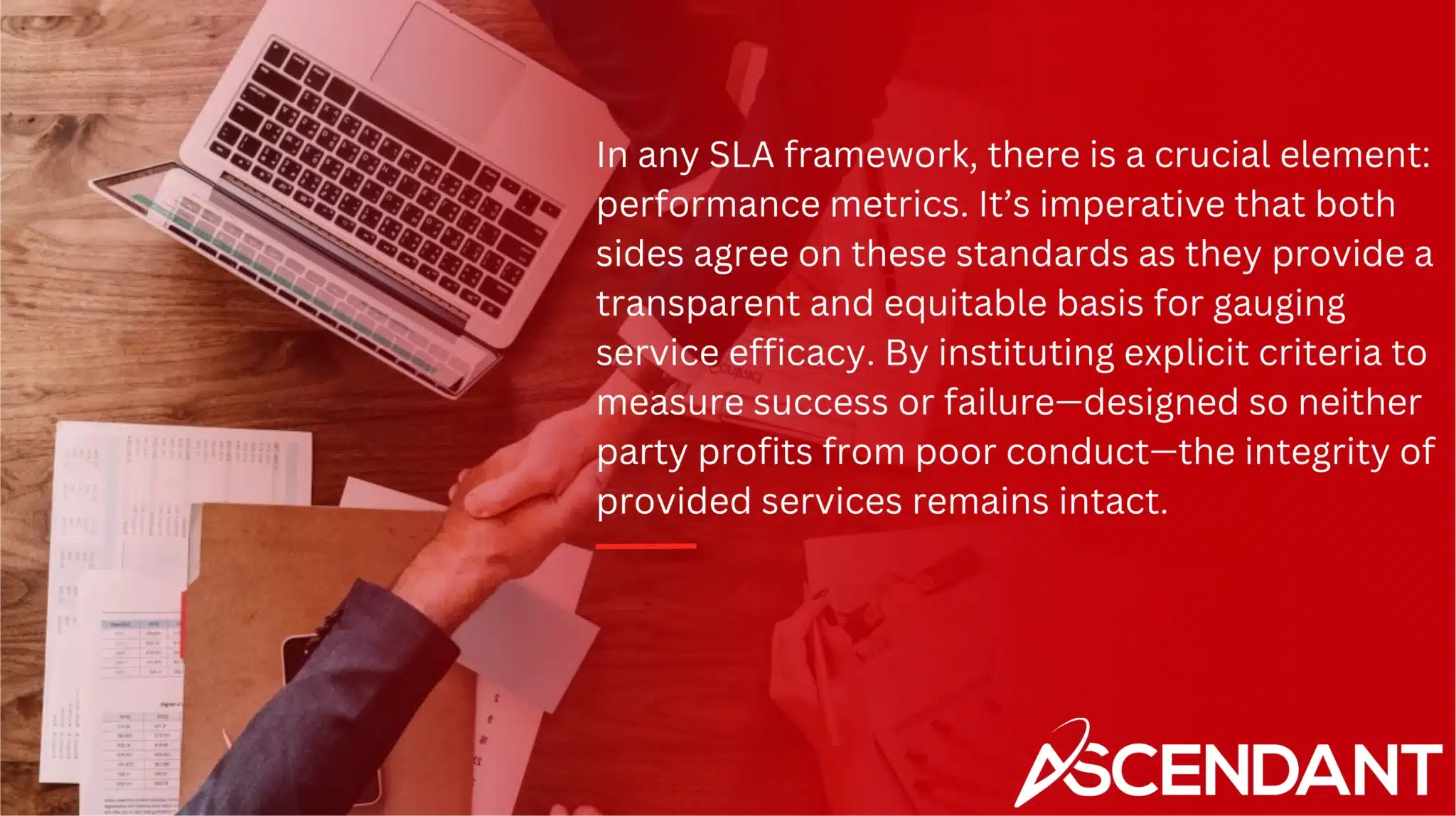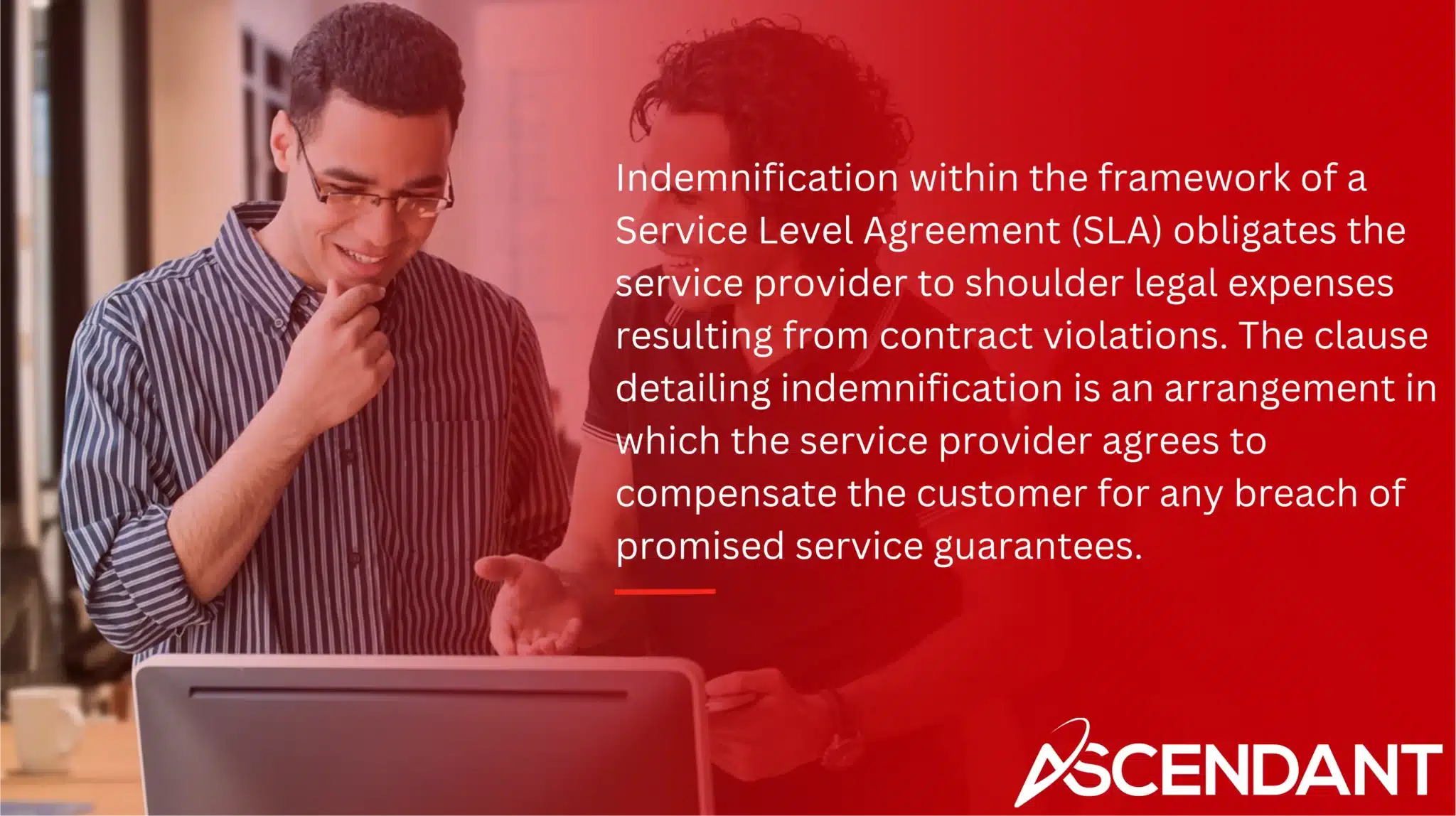A Service Level Agreement (SLA) is a documented contract between a service provider and customer, detailing expected service levels, performance metrics, and responsibilities. Understanding SLAs is crucial for setting clear expectations and enhancing service quality. This guide covers everything you need to know about creating and managing effective SLAs.
In This Article:
- Understanding Service Level Agreements (SLAs)
- Key Components of an SLA
- Types of SLAs
- The Role of Performance Metrics in SLAs
- Benefits of Implementing SLAs
- Best Practices for Writing SLAs
- Common Mistakes to Avoid in SLAs
- Negotiating SLAs with Cloud Service Providers
- Indemnification Clauses in SLAs
- How to Verify Service Levels
- Revising and Updating SLAs
- What Happens When Service Levels Are Not Met?
- Examples of Effective SLAs
Key Takeaways
- Service Level Agreements (SLAs) define service delivery expectations, fostering clarity and accountability between providers and clients.
- Key SLA components include performance metrics, responsibilities of both parties, cancellation conditions, and clear remedies for unmet service levels.
- Regularly reviewing and updating SLAs is crucial to adapting to changing business needs and ensuring long-term effectiveness.
Understanding Service Level Agreements (SLAs)
Service Level Agreements (SLAs) are essential contracts that outline the service performance expectations between a service provider and their customers. These agreements serve as formalized arrangements, detailing what level of service is anticipated by documenting specific metrics and objectives. The key aim of an SLA is to clarify any potential misunderstandings about the range of services provided, ensuring both parties hold a common understanding of the supplier’s obligations. It’s critical for these documents to be in place to maintain transparency throughout all engagements.
Crafting an effective SLA builds confidence between involved parties by explicitly stating duties, anticipated results from services rendered, and steps to take should there be lapses in expected quality levels. By establishing definitive guidelines for accountability and methods for gauging success or failure effectively through implementation. Such detailed agreements can significantly raise client satisfaction rates.
These structured documents also play a vital role in managing communications regarding how services are being performed compared with initial customer hopes and requirements—this aids greatly in preventing tensions or misinterpretations down the line. Overlooking the importance of generating SLAs at an early stage might lead to disputes after services have been delivered due largely because clear standards were not established beforehand—a scenario highlighting just why these agreements shouldn’t be ignored.
Key Components of an SLA
The opening portion of an SLA commonly presents essential details about the agreement, including who is involved and when it commences. This section typically contains elements such as a list of those with a stake in the agreement, objectives, scope of services offered, exclusions to service provision, indicators for assessing performance outcomes, conditions under which the agreement may be dissolved and strategies for addressing situations where agreed-upon targets are not met. Clearly delineating these aspects from the outset assists in establishing accurate expectations between parties.

In any SLA framework, there is a crucial element: performance metrics. It’s imperative that both sides agree on these standards as they provide a transparent and equitable basis for gauging service efficacy. By instituting explicit criteria to measure success or failure—designed so neither party profits from poor conduct—the integrity of provided services remains intact. In instances where established levels aren’t met within an SLA context, there are predetermined consequences or fines meant to encourage compliance with stipulated norms.
Lastly but equally fundamental is detailing what’s expected from each entity engaging in an SLA – this includes pinpointing exceptions, steps to follow should issues require advancing through hierarchical channels, plus safeguards regarding confidential data protection measures must all be explicitly covered in order agreements can feasibly end if necessary comprehensively addresses responsibilities enabling solid support structures governing practical management over rendered services ensuring accountable relations exist throughout tenure.
Types of SLAs
Service Level Agreements (SLAs) are categorized into three fundamental types: Customer-based SLAs, Internal SLAs, and Multilevel SLAs. A Customer-based SLA zeroes in on the service issues that matter to particular customer segments, bundling all relevant services for a single client within one agreement. It’s customized to address the distinctive demands of each client to ensure that service delivery is congruent with their individual needs.
Conversely, Internal SLAs serve as pacts between different teams inside an organization. They establish precise expectations and foster accountability amongst various internal business units.
Lastly, a Multilevel SLA comprises a core section that is universally applicable across all customers paired with specific subsections tailored for diverse customer groups or divisions. This multifaceted arrangement permits customization of the service agreement, which accommodates distinct varieties of services and requisites under one organizational umbrella.
The Role of Performance Metrics in SLAs
Measuring service levels in Service Level Agreements (SLAs) is of paramount importance, and performance metrics play a crucial role in this process. These metrics provide both parties with an explicit understanding of the expected services and how well these services are being delivered. To be effective, it’s imperative that SLAs have clear-cut and feasible objectives. Frequent performance indicators featured in SLAs include measures like uptime requirements, benchmarks for response times, and acceptable error frequencies—all essential for evaluating the dependability of the service provided.
Incorporating additional indicators such as rates of resolution on initial contact and quantities of support tickets can shed light on how efficiently support issues are handled as well as gauge the success rate of self-service resources. In essence, by integrating unambiguous and quantifiable metrics into SLAs, there is enhanced accountability which aids in mitigating conflicts through transparent communication regarding service provision.
Setting precise performance standards assists both providers and clients to regularly align with established key performance indicators (KPIs) along with stipulated service levels specified within their agreements.
Benefits of Implementing SLAs
Service Level Agreements (SLAs) are essential for maintaining high-quality service, as they clarify the expectations and obligations of all involved parties. By setting specific performance metrics within SLAs, the required standards for service providers become measurable and enforceable. This ensures accountability by clearly delineating the expected levels of service that providers must adhere to.
The precise assignment of responsibilities in SLAs minimizes confusion, leading to improved communication when there is mutual agreement among stakeholders on what has been laid out in these agreements. Such consensus enhances not only how services are delivered, but also significantly increases customer satisfaction due to transparent operations.
By incorporating SLAs into their operational framework, organizations can better align their services with what customers anticipate. Doing so facilitates superior outcomes tied directly to a well-structured Service-Based SLA approach, thereby meeting or exceeding client expectations in terms of service provision.
Best Practices for Writing SLAs
Before the Agreement:
It is paramount to define clearly both the purpose and extent of an SLA, to facilitate a mutual grasp of obligations by all involved parties and circumvent misunderstandings. The integration of stakeholder involvement from the outset and their contributions in shaping the SLA is imperative for crafting an all-encompassing contract. To maintain relevance amidst evolving business landscapes and organizational demands, conducting periodic evaluations of the SLA stands as a necessity.
Subsequent Steps:
- Definitively outline the intent and boundaries of your Service Level Agreement (SLA) to ascertain that every participant comprehends their duties, thus preventing miscommunications.
- From inception, actively involve stakeholders in discussions on creating your Service Level Agreement (SLA), taking into account their insights for forging an inclusive pact.
- Implement systematic assessments at predetermined intervals for your Service Level Agreement (SLA) allowing adjustments reflective of changing circumstances within business frameworks or operational requirements.
When formulating objectives within these agreements, it’s crucial they are set with attainability and clarity in mind—this nurtures accountability while providing a solid standard against which service performance can be gauged.
Adhering to these outlined procedures ensures organizations can devise robust Service-Level Agreements that not only align with specific service mandates but also promote shared comprehension amongst parties concerned.
Common Mistakes to Avoid in SLAs
Numerous organizations encounter difficulties in efficiently tracking Service Level Agreements (SLAs), frequently due to a lack of adequate tools for monitoring service performance as it happens. As the nature of business, technical infrastructures, work volumes, and metrics evolve, there is an imperative need to update SLAs accordingly. If automated processes are not put into place for escalating tasks that are past their deadline, this oversight can lead to substantial delays and unresolved problems which may harm relationships with clients.
Inadequate negotiation techniques might result in terms that do not properly represent the service needs of both parties involved. For this reason, it’s critical to consistently evaluate and adjust SLAs so they continue to be pertinent amidst changing circumstances.
By steering clear of these widespread errors, firms can improve the management of their service contracts and preserve a high standard of service performance.
Negotiating SLAs with Cloud Service Providers
SLAs are a fundamental component in the realm of outsourcing contracts and crucial when forming agreements with technology vendors. While negotiating SLAs with cloud service providers is possible, they often show reluctance to alter their standard SLA templates. As such, customers should view these as starting points for Dialogue and strongly consider having them examined by legal professionals. It’s vital to meticulously evaluate these agreements to identify potential risks and address primary concerns that safeguard customer interests.
Most service providers offer standard SLAs which should be thoroughly reviewed by customers, who may then consult with legal advisors on potential modifications. Customer-specific needs can affect both pricing structures and decisions made by suppliers, underscoring the importance of personalizing SLAs where necessary. An IT service provider can act as a mediator during such negotiations.
Should there be scenarios where suppliers cannot satisfy high-availability demands within the existing framework, they might present an alternate solution that better aligns with robustness expectations. Negotiating carefully tailored SLAs is key to ensuring not only that customer service requirements are adequately fulfilled, but also that associated risks are substantially reduced.
Indemnification Clauses in SLAs

Indemnification within the framework of a Service Level Agreement (SLA) obligates the service provider to shoulder legal expenses resulting from contract violations. The clause detailing indemnification is an arrangement in which the service provider agrees to compensate the customer for any breach of promised service guarantees. This implies that if warranty breaches lead to third-party lawsuits, it’s up to the provider to reimburse litigation costs incurred by the customer. Such provisions typically encompass terminology like ‘hold harmless,’ signifying that those offering indemnity are committed to defending and absolving those who are protected by it.
Customers hold power in creating and modifying terms related to indemnification for a more robust protection of their rights and interests. It’s common for service providers themselves to engage in talks around these clauses aiming at capping their potential responsibilities.
Notably, standard SLAs issued by suppliers may not automatically incorporate such indemnity clauses, making it critical for clients to scrutinize these documents: they must be attentive when reviewing them so as to comprehend fully — ensuring defenses against foreseeable judicial or economic hazards through adept negotiation skills can effectively shield customers from adverse outcomes.
How to Verify Service Levels
It is crucial to keep track of a reasonable amount of metrics that resonate with the company’s goals for effective confirmation of service levels. Performance metrics monitoring approaches should incorporate employing software solutions or convening routine gatherings. Verification of service levels can be conducted through web-based platforms or external applications designed for assessing performance data. To oversee business process indicators, such as uptime and security, customers utilizing cloud services have the option to utilize native tools provided by their providers or independent third-party programs.
The Service Level Agreement (SLA) must outline how to report on service performance and set intervals for tracking purposes. Continuous oversight and reporting are imperative in ensuring that service providers adhere to the pre-established service standards, facilitating swift detection and rectification when there are any inconsistencies.
Ensuring verification of these agreed-upon standards assists organizations in preserving exceptional quality within their delivery models and upholding customer satisfaction.
Revising and Updating SLAs
A Service Level Agreement (SLA) should be regarded as a dynamic document that must undergo periodic updates to remain applicable. It is crucial to revise the SLA regularly in order to reflect any alterations in business requirements or technological innovations, ensuring its ongoing effectiveness. Significant shifts within the business environment or technology sector should prompt an evaluation and potential modification of the SLAs. The involvement of all relevant stakeholders during this process guarantees that a wide range of insights are considered and integrated.
It is imperative to embed mechanisms for regular scrutiny and adjustment within the SLA so it can pivot according to evolving demands. Such systematic assessments serve to enhance transparency while confirming that service expectations continue aligning with changes over time.
Incorporating feedback from prior experiences in service delivery into updated versions of SLAs is vital for their continuous improvement. Ensuring these documents stay up-to-date confirms their practicality in managing effective services aligned with current conditions and needs.
What Happens When Service Levels Are Not Met?
A Service Level Agreement (SLA) should specify the compensatory measures to be provided to customers in instances where service providers do not fulfill their agreed-upon responsibilities. These provisions may comprise license extensions or added support as punitive recourse for missing established service levels. Should a failure occur, SLAs can stipulate reductions in payments through service credits reflecting unmet standards, effectively serving as financial penalties against the provider with predetermined amounts.
It is crucial that an SLA incorporates a transparent procedure for handling disputes so that any arising issues are resolved efficiently and fairly. The calculation of service credits typically reflects the degree of deviation from promised service levels. As part of these arrangements, consequences for failing to achieve those standards might include both disciplinary actions and positive inducements designed to prevent future lapses. Continuous shortcomings could ultimately result in ending the agreement underpinned by specified performance criteria.
The inclusion of such clauses within SLAs guarantees there are explicit repercussions associated with non-achievement of stated benchmarks, safeguarding customer rights while promoting exemplary standards within realms of service delivery.
Examples of Effective SLAs
Effective Service Level Agreements (SLAs) typically encompass an in-depth section on service availability, which clearly defines the scope of coverage under the agreement. This portion delineates operational periods, schedules for maintenance and any exceptions to guarantee clients are fully aware of when they can expect services to be accessible. A section dedicated to service management should offer intricate details regarding support structures and methods employed in both delivering and overseeing the provided services.
Each SLA ought to be crafted with precision to cater specifically to distinct business demands and client needs. As illustrated by BMC’s successful implementations that serve 86% of companies listed within Forbes Global 50, this bespoke approach is pivotal in fostering effective SLA agreements among top-tier corporations.
Appendices can provide storage for pertinent data not suitable for inclusion elsewhere within the document, such as pricing frameworks and applicable fees. These components emphasize how tailoring SLAs accordingly plays a crucial role in delivering efficient services while achieving heightened levels of customer satisfaction across diverse clientele bases.
Summary
Service Level Agreements (SLAs) serve as vital instruments to outline and control the service expectations between clients and their service providers. A thorough comprehension of SLAs’ fundamental elements, categories, and performance indicators is crucial. Adhering to established best practices for creating and negotiating these contracts can guarantee elevated service performance levels along with heightened customer satisfaction. It’s important to consistently revise and refresh SLAs while also having strategies in place for instances when set service standards are not met. Proper application of effective SLAs contributes significantly to enhanced business outcomes and fortified client partnerships. Equipped with this insight, you’re now more adept at formulating, discussing, and administering SLAs that align with your distinct requirements for services as well as your broader business objectives.
 Frequently Asked Questions
Frequently Asked Questions
What is a Service Level Agreement (SLA)?
An SLA, or Service Level Agreement, is an official contract that stipulates the expected level of service and performance indicators agreed upon by a customer and a service provider. It explicitly establishes both parties’ obligations.
This document acts as an essential standard for measuring accountability and service delivery effectiveness.
What are the key components of an SLA?
Essential elements within a Service Level Agreement (SLA) include identifying the stakeholders, defining objectives, describing the service provided, detailing exclusions, outlining performance metrics, specifying conditions for termination, and establishing a strategy for dealing with goals that are not achieved.
Such components are crucial in maintaining transparency and responsibility among all parties bound by the level agreement.
How can I verify if service levels are being met?
Employ software tools to track performance metrics in order to ascertain compliance with service levels. Regularly convene meetings for the purpose of reviewing progress and maintaining accountability.
By adopting this strategy, you will have a transparent understanding of whether service level commitments are being fulfilled.
What happens if the service provider fails to meet the agreed service levels?
If the service provider fails to meet the agreed service levels, the Service Level Agreement (SLA) typically stipulates compensations like service credits or financial penalties, and repeated failures may result in the termination of the SLA.
Why is it important to regularly update SLAs?
It is essential to frequently revise Service Level Agreements (SLAs) to ensure they remain in sync with changing business requirements and technological progress, which guarantees that these agreements proficiently regulate service delivery.
By doing so, the relevance of the SLAs is preserved along with their ability to guide operations efficiently.

